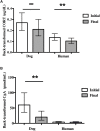Physiological Indicators of Attachment in Domestic Dogs (Canis familiaris) and Their Owners in the Strange Situation Test
- PMID: 31396061
- PMCID: PMC6664005
- DOI: 10.3389/fnbeh.2019.00162
Physiological Indicators of Attachment in Domestic Dogs (Canis familiaris) and Their Owners in the Strange Situation Test
Abstract
Behaviorally, attachment is demonstrated when one individual maintains close proximity to another individual and shows distress upon separation. For 29 owner-dog dyads, we employed a modified Ainsworth's Strange Situation Test (SST) to investigate whether both members would show a physiological reaction to separation. Dogs experienced a series of separation from and reuniting events with their owners and were introduced to a stranger. Before and after the SST, saliva samples were taken from each dyad to measure stress-related analytes: cortisol (CORT) and chromogranin A (CgA). Dogs exhibited attachment behaviors toward owners as evidenced by more time spent in close proximity, more contact initiated and less time spent near the door, compared to episodes with the stranger. Dogs that initiated more contact with their owners in re-uniting episodes had lower CgA than dogs that initiated less contact, but their owners had higher CgA levels. Also during re-uniting episodes, dogs and owners spent more time near each other when owner CgA levels were low, owner CORT levels were high, and the dog had owner-reported separation anxiety. During the episodes alone with the stranger, dogs with higher CORT spent more time with the stranger. Finally, dogs' initial CgA levels were correlated with their owner's initial CORT levels, and dog final CORT levels were correlated with their owners' final CORT levels, suggesting some hormonal synchrony within the dyad. As all owner-dog dyads were assessed as securely attached, attachment style differences could not explain variation in hormonal or behavioral results. These results suggest that dogs may respond to owner hormonal state and/or behavior and demonstrate that individual differences in responses to a behavioral challenge reflect the stress physiology of both dogs and their owners.
Keywords: attachment; chromogranin A (CgA); cortisol; dog; strange situation test.
Figures




Similar articles
-
Dog-Owner Attachment Is Associated With Oxytocin Receptor Gene Polymorphisms in Both Parties. A Comparative Study on Austrian and Hungarian Border Collies.Front Psychol. 2018 Apr 5;9:435. doi: 10.3389/fpsyg.2018.00435. eCollection 2018. Front Psychol. 2018. PMID: 29674985 Free PMC article.
-
"Like owner, like dog": correlation between the owner's attachment profile and the owner-dog bond.PLoS One. 2013 Oct 30;8(10):e78455. doi: 10.1371/journal.pone.0078455. eCollection 2013. PLoS One. 2013. PMID: 24205235 Free PMC article.
-
Links between an Owner's Adult Attachment Style and the Support-Seeking Behavior of Their Dog.Front Psychol. 2017 Nov 30;8:2059. doi: 10.3389/fpsyg.2017.02059. eCollection 2017. Front Psychol. 2017. PMID: 29250009 Free PMC article.
-
Dog Owners' Interaction Styles: Their Components and Associations with Reactions of Pet Dogs to a Social Threat.Front Psychol. 2016 Dec 20;7:1979. doi: 10.3389/fpsyg.2016.01979. eCollection 2016. Front Psychol. 2016. PMID: 28066298 Free PMC article.
-
Impulsivity as a trait in domestic dogs (Canis familiaris): A systematic review and meta-analysis.J Comp Psychol. 2024 Feb;138(1):20-31. doi: 10.1037/com0000352. Epub 2023 Aug 3. J Comp Psychol. 2024. PMID: 37535517
Cited by
-
The impact of the COVID-19 pandemic on a cohort of Labrador retrievers in England.BMC Vet Res. 2022 Jun 24;18(1):246. doi: 10.1186/s12917-022-03319-z. BMC Vet Res. 2022. PMID: 35751072 Free PMC article.
-
Physiological Indicators of Acute and Chronic Stress in Securely and Insecurely Attached Dogs Undergoing a Strange Situation Procedure (SSP): Preliminary Results.Vet Sci. 2022 Sep 23;9(10):519. doi: 10.3390/vetsci9100519. Vet Sci. 2022. PMID: 36288132 Free PMC article.
-
Mechanisms of Social Attachment Between Children and Pet Dogs.Animals (Basel). 2024 Oct 20;14(20):3036. doi: 10.3390/ani14203036. Animals (Basel). 2024. PMID: 39457966 Free PMC article. Review.
-
Domestication and exposure to human social stimuli are not sufficient to trigger attachment to humans: a companion pig-dog comparative study.Sci Rep. 2024 Jul 8;14(1):14058. doi: 10.1038/s41598-024-63529-3. Sci Rep. 2024. PMID: 38977716 Free PMC article.
-
The Urinary Hormonal State of Cats Associated With Social Interaction With Humans.Front Vet Sci. 2021 Jul 26;8:680843. doi: 10.3389/fvets.2021.680843. eCollection 2021. Front Vet Sci. 2021. PMID: 34381833 Free PMC article.
References
LinkOut - more resources
Full Text Sources
Research Materials

